-
栈和队列经典笔试题
安静的夜晚 你在想谁吗
栈和队列的回顾💻
栈🩳
栈是一种特殊的线性表,其只允许在固定的一端进行插入和删除元素操作。进行数据插入和删除操作的一端称为栈顶,另一端称为栈底。栈中的数据元素遵守后进先出LIFO(Last In First Out)的原则。
一般使用数组实现栈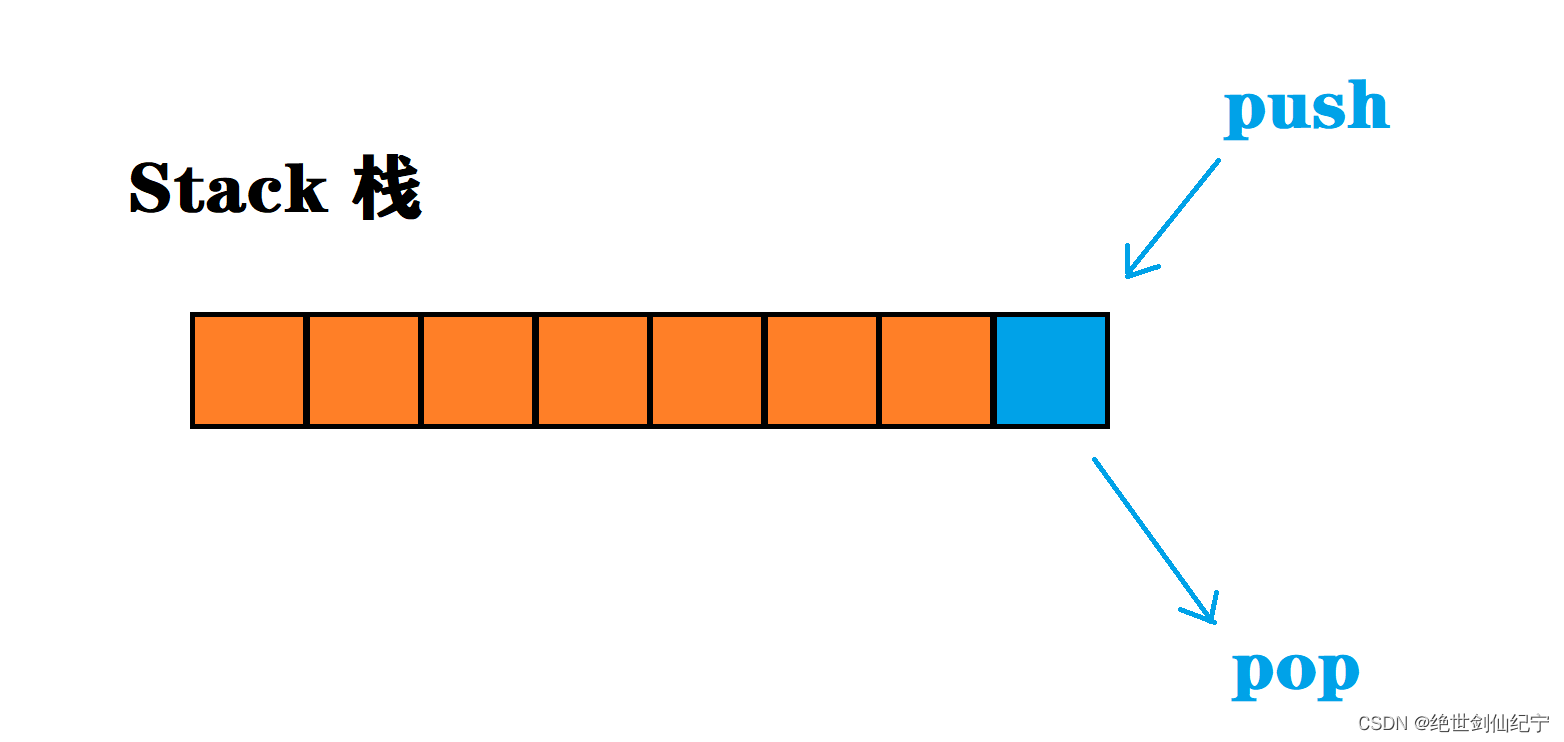
物理图表示入栈和出栈(后进先出)
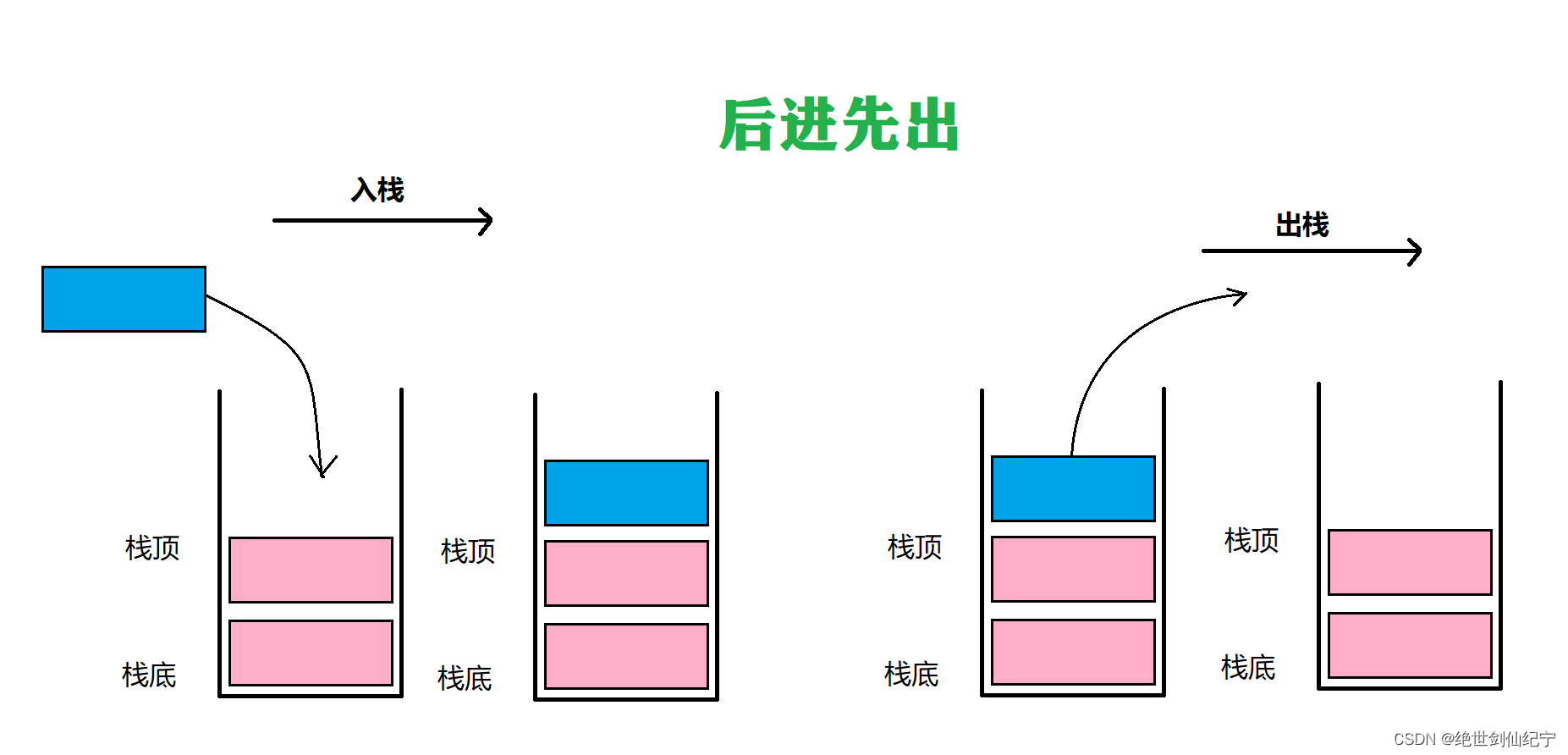
队列👟
队列:只允许在一端进行插入数据操作,在另一端进行删除数据操作的特殊线性表,队列具有先进先出。FIFO(First In First Out)
入队列:进行插入操作的一端称为队尾 ;出队列:进行删除操作的一端称为队头。

物理图表示入队和出队(先进先出)
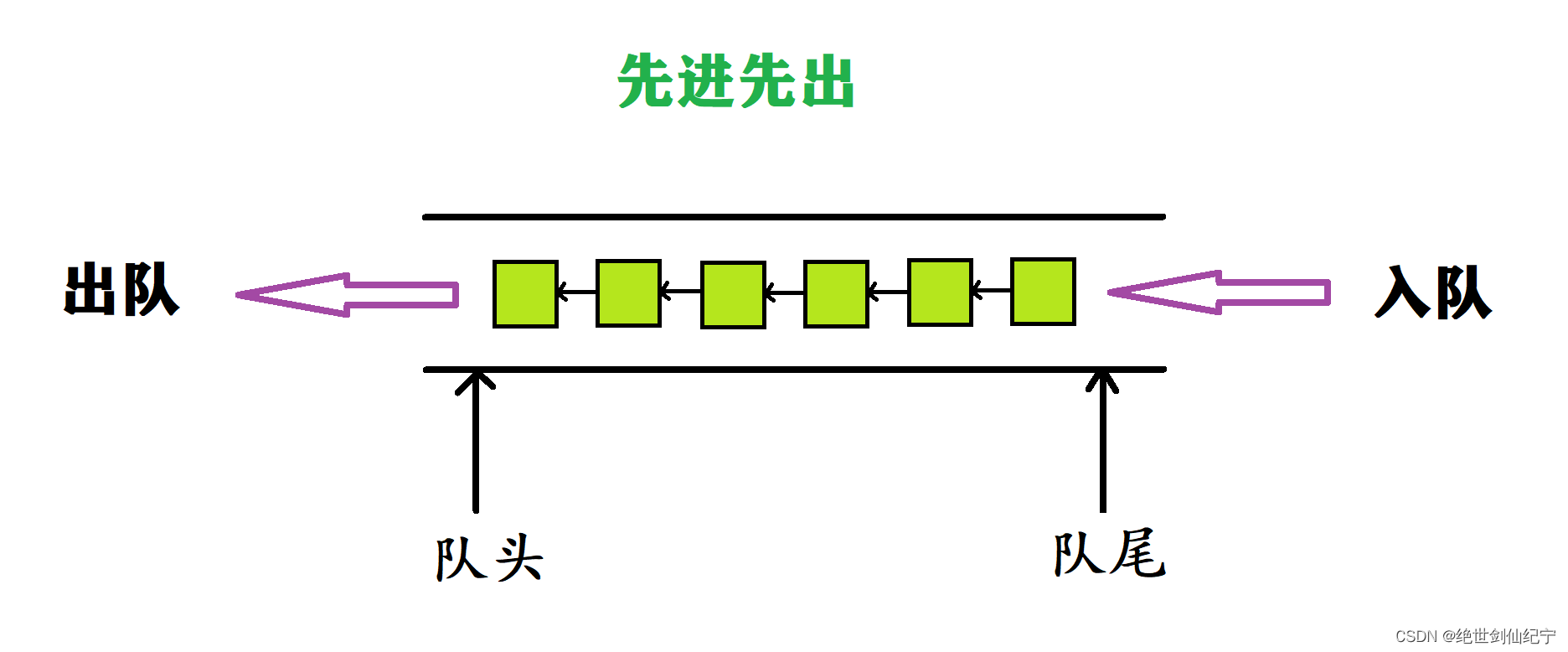
栈和队列经典笔试题🔋
有效的括号🎸
力扣题目链接:有效的括号
给定一个只包括 ‘(’,‘)’,‘{’,‘}’,‘[’,‘]’ 的字符串 s ,判断字符串是否有效。有效字符串需满足:
- 左括号必须用相同类型的右括号闭合。
- 左括号必须以正确的顺序闭合。
- 每个右括号都有一个对应的相同类型的左括号。
下面是几个示例:
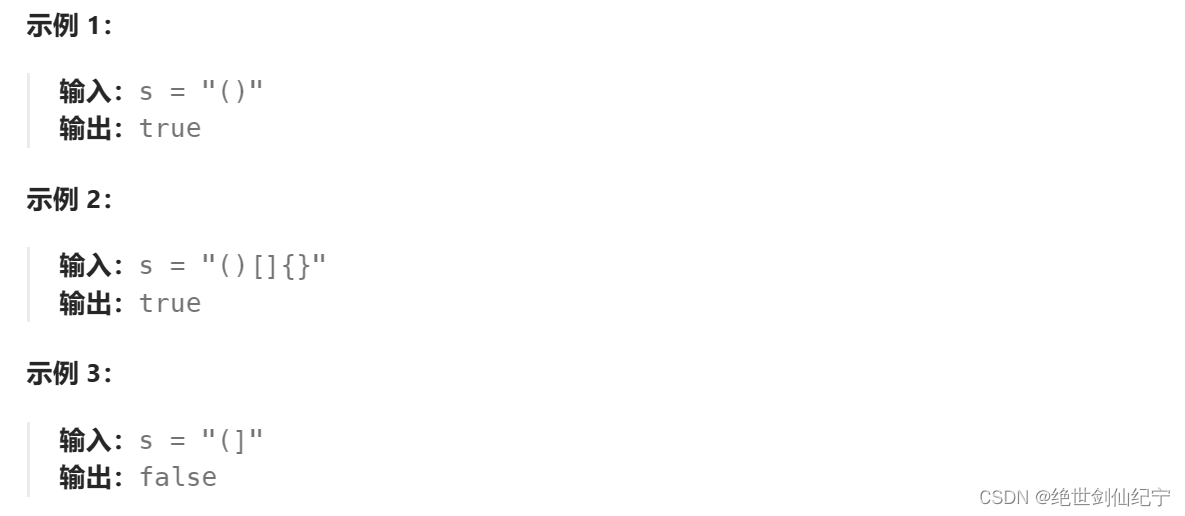
题目分析
本题通俗的来讲,就是判断括号是否是匹配的,即括号的类型是否匹配和数量是否匹配。我们可以使用栈的知识来解决这道题:从给定序列的第一个字符开始遍历,如果遍历遇到左括号,就入栈;如果遍历遇到右括号,则先取栈顶元素,再出栈(因为合适的匹配必须是栈),判断栈顶元素与这个右括号是否匹配。
需要注意的点有:尽量每次循环只遍历一个元素或只对一个元素进行判断,这样可以保证数量匹配的正确性。当遍历一个元素不是左括号的时候,就判断栈中是否为空,如果栈为空,则说明数量是不匹配的;如果栈不为空,则要对这个右括号是否和栈顶的左括号匹配进行判断。
其实本题比较复杂的还是结构的问题,毕竟不用C++的,这个栈的功能需要我们自己去实现。
力扣代码(含栈结构)typedef char STDataType; typedef struct Stack { STDataType* a; int top; int capacity; }ST; void STInit(ST* ps); void STDestroy(ST* ps); void STPush(ST* ps, STDataType x); void STPop(ST* ps); STDataType STtop(ST* ps); int STsize(ST* ps); bool STEmpty(ST* ps); void STInit(ST* ps) { ps->a = NULL; ps->top = 0; ps->capacity = 0; } void STDestroy(ST* ps) { assert(ps); free(ps->a); ps->a = NULL; ps->capacity = 0; ps->top = 0; } void STPush(ST* ps, STDataType x) { assert(ps); if (ps->top == ps->capacity) { int NEWcapacity = (ps->capacity == 0) ? 4 : (ps->capacity * 2); //扩容 STDataType* tmp = realloc(ps->a, sizeof(STDataType) * NEWcapacity); if (tmp == NULL) { perror("realloc fail"); exit(-1); } ps->a = tmp; ps->capacity = NEWcapacity; } ps->a[ps->top] = x; ps->top++; } void STPop(ST* ps) { assert(ps); assert(ps->top > 0); ps->top--; } //获取栈顶元素 STDataType STtop(ST* ps) { assert(ps); assert(ps->top>0); return ps->a[ps->top-1]; } int STsize(ST* ps) { assert(ps); return ps->top; } bool STEmpty(ST* ps) { assert(ps); return (ps->top == 0); } bool isValid(char * s){ ST st; STInit(&st); char stack_top; while(*s) { if(*s=='('||*s=='['||*s=='{') { STPush(&st,*s); } else { if(STEmpty(&st)) { STDestroy(&st); return false; } stack_top=STtop(&st); STPop(&st); if(*s==')'&&stack_top!='('|| *s==']'&&stack_top!='['|| *s=='}'&&stack_top!='{') { STDestroy(&st); return false; } } s++; } if(!STEmpty(&st)) { STDestroy(&st); return false; } return true; }- 1
- 2
- 3
- 4
- 5
- 6
- 7
- 8
- 9
- 10
- 11
- 12
- 13
- 14
- 15
- 16
- 17
- 18
- 19
- 20
- 21
- 22
- 23
- 24
- 25
- 26
- 27
- 28
- 29
- 30
- 31
- 32
- 33
- 34
- 35
- 36
- 37
- 38
- 39
- 40
- 41
- 42
- 43
- 44
- 45
- 46
- 47
- 48
- 49
- 50
- 51
- 52
- 53
- 54
- 55
- 56
- 57
- 58
- 59
- 60
- 61
- 62
- 63
- 64
- 65
- 66
- 67
- 68
- 69
- 70
- 71
- 72
- 73
- 74
- 75
- 76
- 77
- 78
- 79
- 80
- 81
- 82
- 83
- 84
- 85
- 86
- 87
- 88
- 89
- 90
- 91
- 92
- 93
- 94
- 95
- 96
- 97
- 98
- 99
- 100
- 101
- 102
- 103
- 104
- 105
- 106
- 107
- 108
- 109
- 110
- 111
当代码在所有不满足的情况下依旧没有返回 false 的时候,则说明它是满足括号的有效性的。
用队列实现栈 🕯
力扣题目链接:用队列实现栈
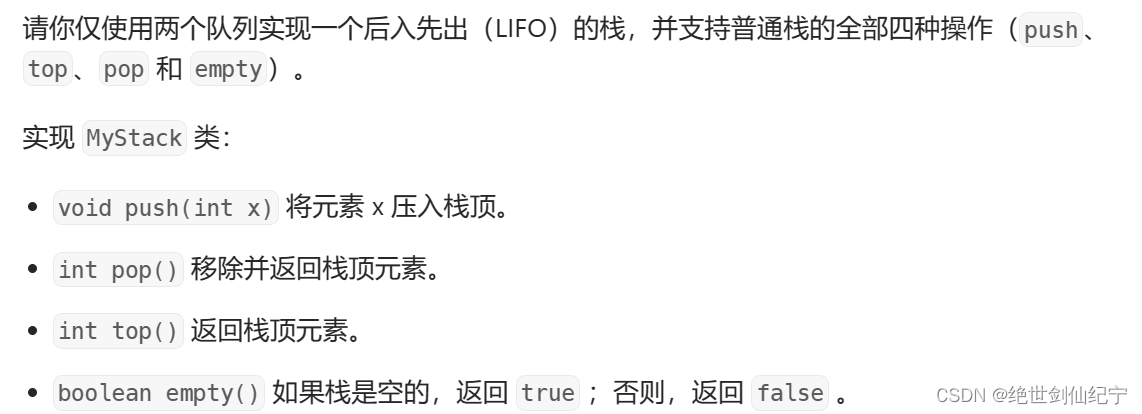
你只能使用队列的基本操作 —— 也就是 push to back、peek/pop from front、size 和 is empty 这些操作。
你所使用的语言也许不支持队列。 你可以使用 list (列表)或者 deque(双端队列)来模拟一个队列 , 只要是标准的队列操作即可。范例:
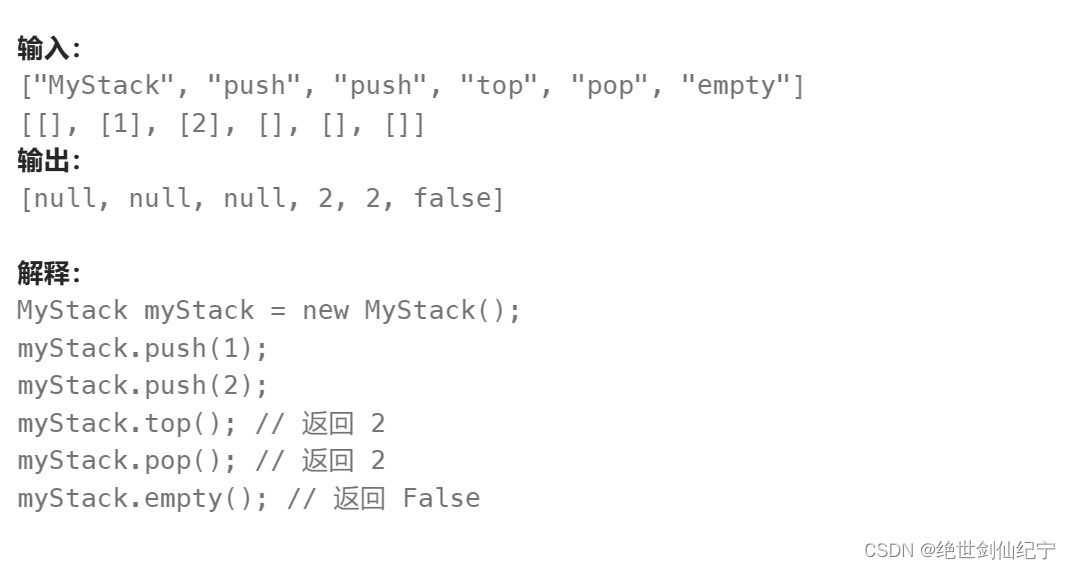
题目分析及思路
队列是先进先出,要实现一个后进先出的栈,一个队列肯定是不行的,必须使用两个队列来互相导着来实现。例如,我现在要对这个数据结构入4个元素:1 2 3 4
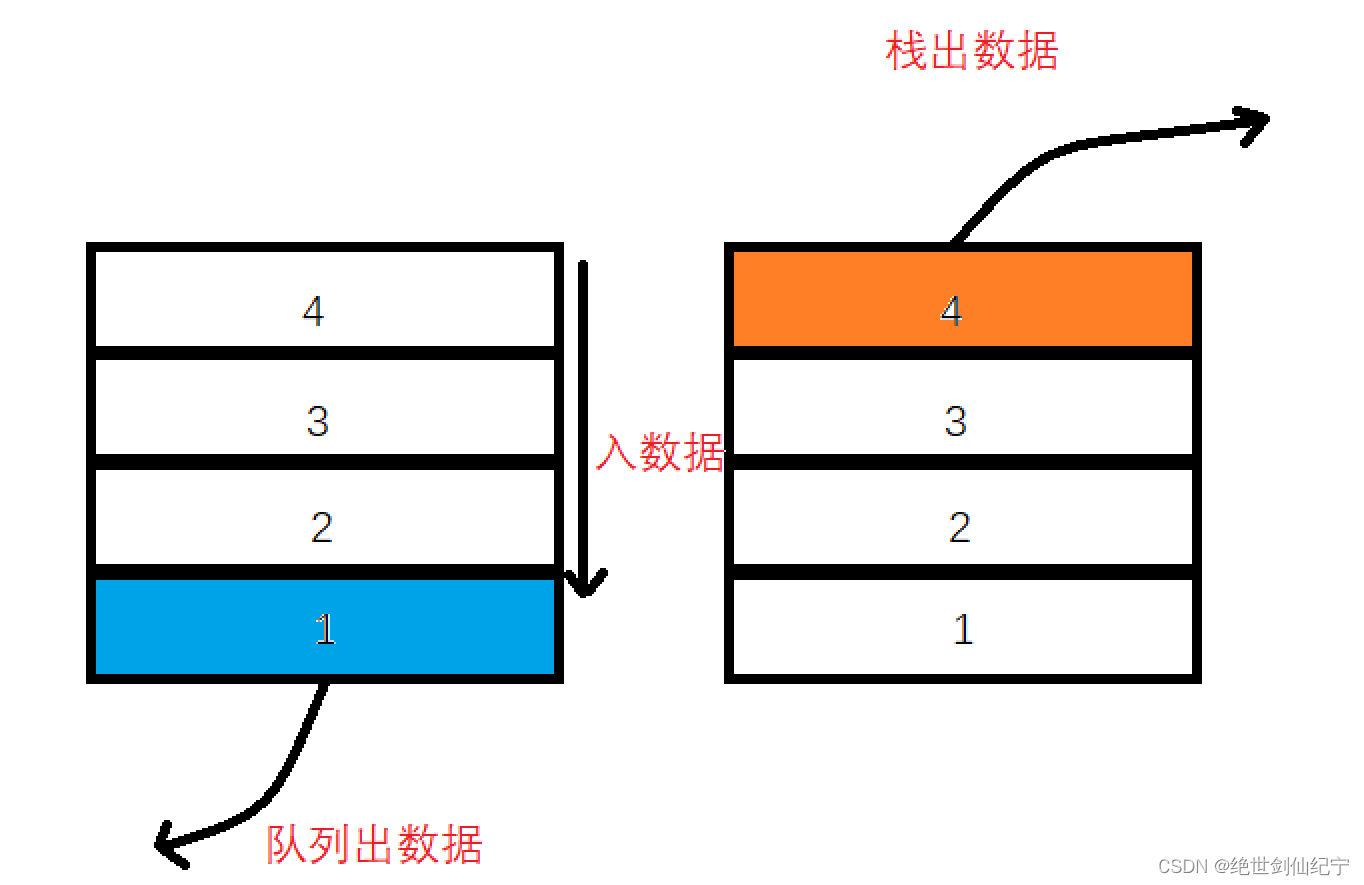
队列只能 pop 先 push 的元素,而要达到将最后进入的元素 pop 的目的,就需要另一个队列来帮忙了:先将所有元素都push到队列1,取 队列1 头位置的元素,将它 push 到 队列2 中后,再将 队列1 中这个元素 pop 掉。如此往复,直到 队列1 中只剩下一个元素,这就是栈结构中需要 pop 的元素。
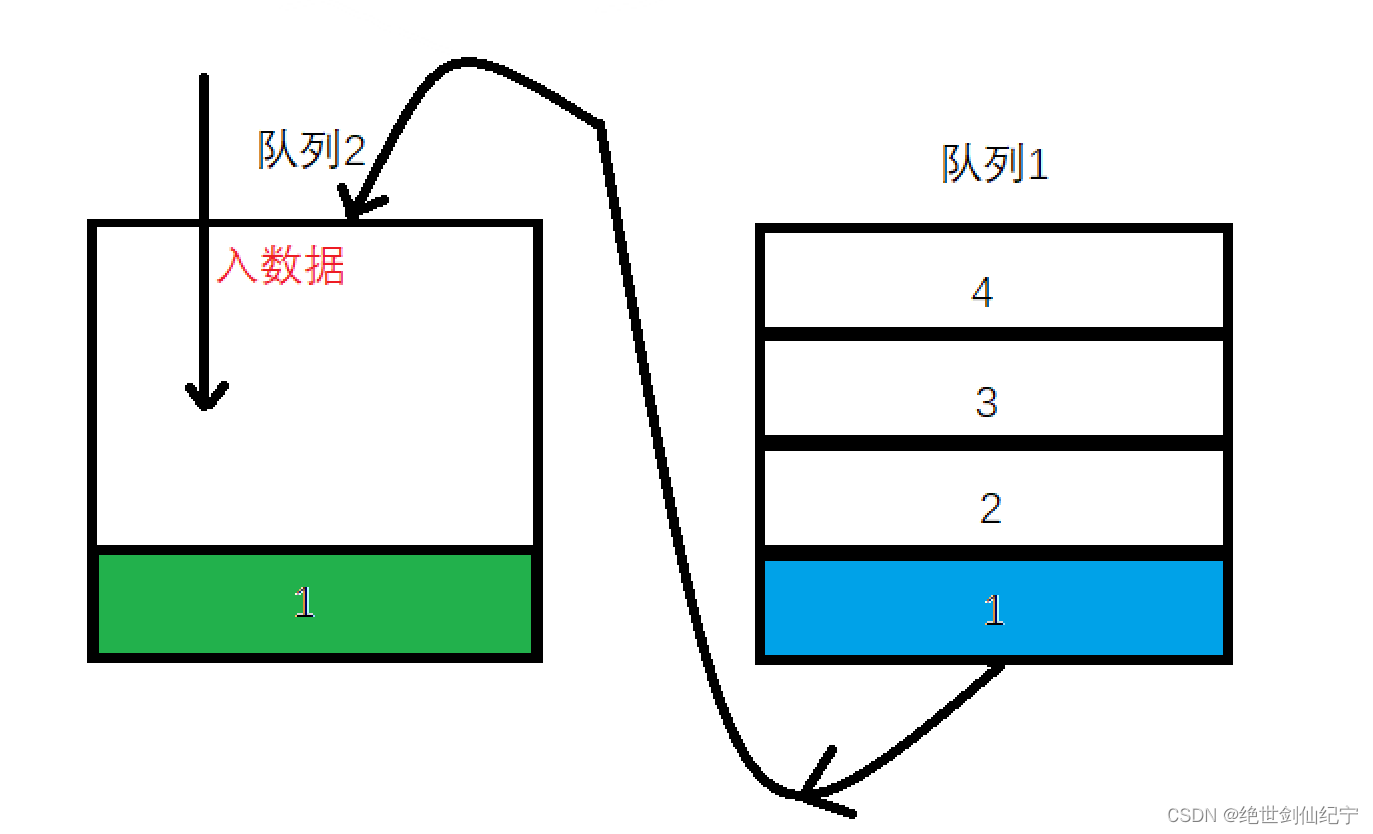
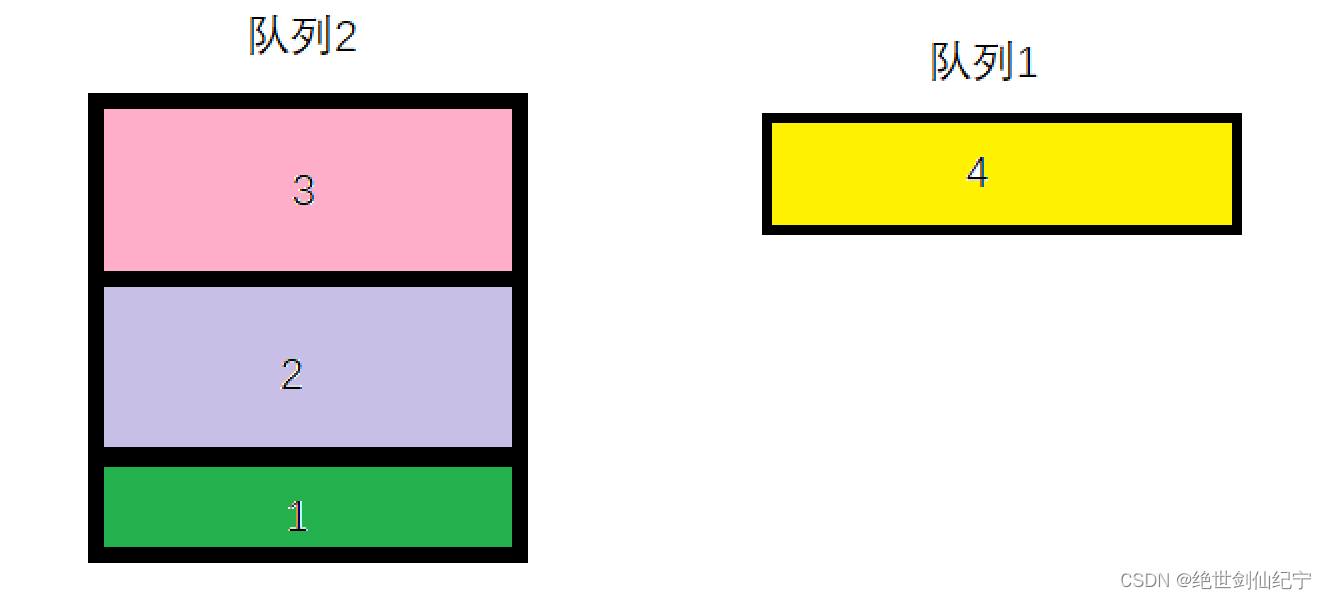
再将最后这个元素pop掉,就相当于将栈结构里的栈顶元素pop掉了。这样就实现了栈的pop功能。
在上面的例子中,我们可以总结出队列实现栈的一般规律:实现push数据,就往空的队列里push;实现pop数据,先将费控队列的前n-1个元素导入空队列,并pop这n-1个元素,最后将剩下的那个元素pop掉即可实现栈的pop功能。
力扣代码(含结构)typedef int QDataType; typedef struct QueueNode { QDataType data; struct QueueNode* next; }QNode; typedef struct Queue { QNode* head; QNode* tail; int size; }Que; void QueueInit(Que*pq); void QueueDestroy(Que* pq); void QueuePush(Que* pq, QDataType x); void QueuePop(Que* pq); QDataType QueueFront(Que* pq); QDataType QueueBack(Que* pq); bool QueueEmpty(Que* pq); int QueueSize(Que* pq); void QueueInit(Que* pq) { assert(pq); pq->head = pq->tail = NULL; pq->size = 0; } void QueueDestroy(Que* pq) { assert(pq); QNode* cur = pq->head; while (cur) { QNode* next = cur->next; free(cur); cur = next; } } void QueuePush(Que* pq, QDataType x) { assert(pq); QNode* nownode = (QNode*)malloc(sizeof(QNode)); if (nownode == NULL) { perror("malloc fail"); exit(-1); } nownode->data = x; nownode->next = NULL; if (pq->tail == NULL) { pq->head = pq->tail = nownode; } else { pq->tail->next = nownode; pq->tail = nownode; } pq->size++; } void QueuePop(Que* pq) { assert(pq); assert(pq->head != NULL); if (pq->head->next == NULL) { free(pq->head); pq->head = pq->tail = NULL; } else { QNode* next = pq->head->next; free(pq->head); pq->head = next; } pq->size--; } QDataType QueueFront(Que* pq) { assert(pq); assert(pq->head != NULL); return pq->head->data; } QDataType QueueBack(Que* pq) { assert(pq); assert(pq->head!=NULL); return pq->tail->data; } bool QueueEmpty(Que* pq) { assert(pq); return pq->head == NULL; } int QueueSize(Que* pq) { assert(pq); return pq->size; } typedef struct { Que q1,q2; } MyStack; MyStack* myStackCreate() { MyStack*pst=(MyStack*)malloc(sizeof(MyStack)); QueueInit(&pst->q1);//->的优先级高于&,其实是&(pst->q1),将定义的结构体变量的地址传过去 QueueInit(&pst->q2); return pst; } void myStackPush(MyStack* obj, int x) { if(!QueueEmpty(&obj->q1)) { QueuePush(&obj->q1,x); } else { QueuePush(&obj->q2,x); } } int myStackPop(MyStack* obj) { Que*empty=&obj->q1; Que*nonEmpty=&obj->q2; if(!QueueEmpty(&obj->q1)) { empty=&obj->q2; nonEmpty=&obj->q1; } //把非空队列的前size-1个元素push到空队列 while(QueueSize(nonEmpty)>1) { QueuePush(empty,QueueFront(nonEmpty)); QueuePop(nonEmpty); } int top=QueueFront(nonEmpty); QueuePop(nonEmpty); return top; } int myStackTop(MyStack* obj) { if(QueueEmpty(&obj->q1)) { return QueueBack(&obj->q2); } else { return QueueBack(&obj->q1); } } bool myStackEmpty(MyStack* obj) { return QueueEmpty(&obj->q1)&&QueueEmpty(&obj->q2);} void myStackFree(MyStack* obj) { QueueDestroy(&obj->q1); QueueDestroy(&obj->q2); free(obj); } /** * Your MyStack struct will be instantiated and called as such: * MyStack* obj = myStackCreate(); * myStackPush(obj, x); * int param_2 = myStackPop(obj); * int param_3 = myStackTop(obj); * bool param_4 = myStackEmpty(obj); * myStackFree(obj); */- 1
- 2
- 3
- 4
- 5
- 6
- 7
- 8
- 9
- 10
- 11
- 12
- 13
- 14
- 15
- 16
- 17
- 18
- 19
- 20
- 21
- 22
- 23
- 24
- 25
- 26
- 27
- 28
- 29
- 30
- 31
- 32
- 33
- 34
- 35
- 36
- 37
- 38
- 39
- 40
- 41
- 42
- 43
- 44
- 45
- 46
- 47
- 48
- 49
- 50
- 51
- 52
- 53
- 54
- 55
- 56
- 57
- 58
- 59
- 60
- 61
- 62
- 63
- 64
- 65
- 66
- 67
- 68
- 69
- 70
- 71
- 72
- 73
- 74
- 75
- 76
- 77
- 78
- 79
- 80
- 81
- 82
- 83
- 84
- 85
- 86
- 87
- 88
- 89
- 90
- 91
- 92
- 93
- 94
- 95
- 96
- 97
- 98
- 99
- 100
- 101
- 102
- 103
- 104
- 105
- 106
- 107
- 108
- 109
- 110
- 111
- 112
- 113
- 114
- 115
- 116
- 117
- 118
- 119
- 120
- 121
- 122
- 123
- 124
- 125
- 126
- 127
- 128
- 129
- 130
- 131
- 132
- 133
- 134
- 135
- 136
- 137
- 138
- 139
- 140
- 141
- 142
- 143
- 144
- 145
- 146
- 147
- 148
- 149
- 150
- 151
- 152
- 153
- 154
- 155
- 156
- 157
- 158
- 159
- 160
- 161
- 162
- 163
- 164
- 165
- 166
- 167
- 168
- 169
- 170
- 171
- 172
- 173
- 174
用栈实现队列🔭
力扣题目链接:用栈实现队列
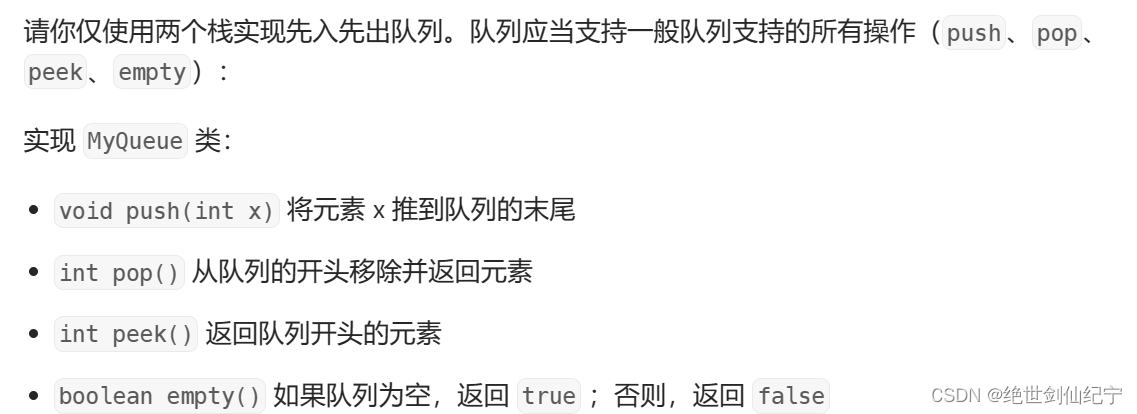
你 只能 使用标准的栈操作 —— 也就是只有 push to top, peek/pop from top, size, 和 is empty 操作是合法的。
你所使用的语言也许不支持栈。你可以使用 list 或者 deque(双端队列)来模拟一个栈,只要是标准的栈操作即可。
范例:
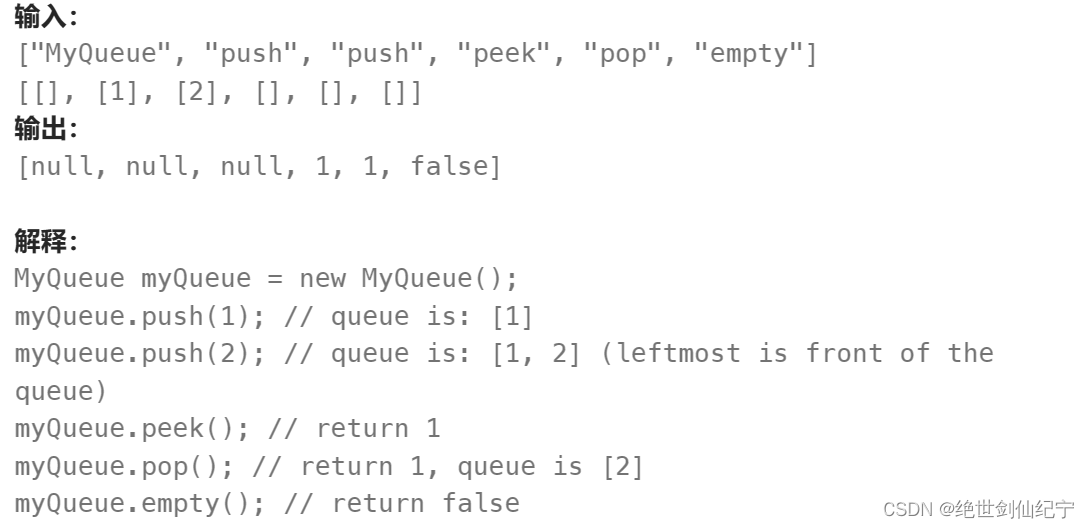
题目分析及思路
题目要求只使用栈的基本操作实现一个队列,这就需要两个栈进行‘合作’来完成。
例如,现在要往队列中 push 四个数据1,2,3,4。
创建两个栈,一个pushst,一个popst,如图,先将这四个数据push到 pushst 这个栈中。
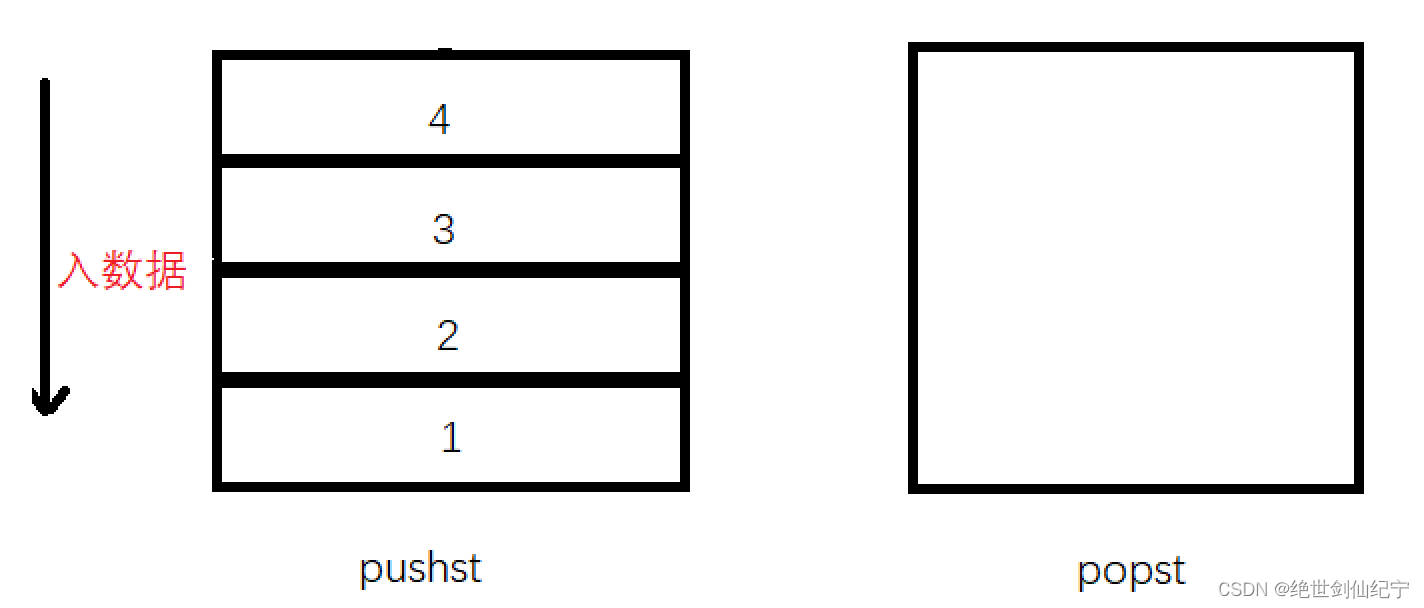
现在,如果要实现队列的 pop 操作,就要将数据1 删除,但栈只能pop栈顶元素,所以只能先将pushst中的‘上面’的三个数据先导过来(取栈顶元素,再pop),然后数据1 就变成了 pushst 的栈顶元素,直接pop即可。

接下来,如果队列还需要 pop 数据的话,只需要在 popst 中 pop 即可。
如果要 push 数据,直接push 到pushst中,再次push后,如果要pop数据,需要将popst中的数据pop完后(直接取栈顶元素),将 pushst 中新push 的 n-1 个数据先导过去,再用上面的方式(出popst中的数据即可)。
总结:定义两个栈,队列需要push数据的时候,先往pushst中push数据(此时栈popst中为空),首次需要pop数据的时候,先将pushst中push的n-1个数据导入popst中,然后将最后一个元素pop掉,这就是队列要pop的头。当将n-1个数据导入popst中后,如果队列再要pop数据,就直接使用栈 popst 进行pop数据,入数据的时候就继续在pushst中压栈,当popst中的数据pop完了直接还要pop的话,就需要再将pushst中的n-1个元素导过去,如此往复…
力扣代码(含结构)typedef int STDataType; typedef struct Stack { STDataType* a; int top;//栈顶位置 int capacity;//栈空间大小 }ST; void STInit(ST* ps); void STPush(ST* ps,STDataType x); void STPrint(ST* ps); void STPop(ST* ps); void STDestroy(ST* ps); STDataType STTop(ST* ps); int STSize(ST* ps); bool STEmpty(ST* ps); void STInit(ST* ps) { assert(ps); ps->a = NULL; ps->capacity = 0; ps->top = 0; } void STPush(ST* ps, STDataType x) { assert(ps); if (ps->capacity==ps->top) { int newcapacity = (ps->capacity == 0) ? 4 : ps->capacity * 2; STDataType* tmp = (STDataType*)realloc(ps->a, newcapacity * sizeof(ps->a)); if (tmp == NULL) { perror("realloc fail"); exit(-1); } ps->capacity = newcapacity; ps->a = tmp; } ps->a[ps->top] = x; ps->top++; } void STPrint(ST* ps) { assert(ps); int i = 0; for (i = 0; i < ps->top; i++) { printf("%d ", ps->a[i]); } printf("\n"); } void STPop(ST* ps) { assert(ps); assert(ps->top>0); (ps->top)--; } void STDestroy(ST* ps) { assert(ps); free(ps->a); ps->a = NULL; ps->capacity = ps->top = 0; } STDataType STTop(ST* ps) { assert(ps); assert(ps->top > 0); return ps->a[ps->top - 1]; } int STSize(ST* ps) { assert(ps); return ps->top; } bool STEmpty(ST* ps) { assert(ps); return ps->top == 0; } typedef struct { ST pushst; ST popst; } MyQueue; MyQueue* myQueueCreate() { MyQueue*obj=(MyQueue*)malloc(sizeof(MyQueue)); STInit(&obj->pushst); STInit(&obj->popst); return obj; } void myQueuePush(MyQueue* obj, int x) { STPush(&obj->pushst,x); } int myQueuePop(MyQueue* obj) { int front=myQueuePeek(obj); STPop(&obj->popst); return front; } int myQueuePeek(MyQueue* obj) { if(STEmpty(&obj->popst)) { while(STSize(&obj->pushst)>0) { STPush(&obj->popst,STTop(&obj->pushst)); STPop(&obj->pushst); } } return STTop(&obj->popst); } bool myQueueEmpty(MyQueue* obj) { return STEmpty(&obj->popst)&&STEmpty(&obj->pushst); } void myQueueFree(MyQueue* obj) { STDestroy(&obj->pushst); STDestroy(&obj->popst); free(obj); }- 1
- 2
- 3
- 4
- 5
- 6
- 7
- 8
- 9
- 10
- 11
- 12
- 13
- 14
- 15
- 16
- 17
- 18
- 19
- 20
- 21
- 22
- 23
- 24
- 25
- 26
- 27
- 28
- 29
- 30
- 31
- 32
- 33
- 34
- 35
- 36
- 37
- 38
- 39
- 40
- 41
- 42
- 43
- 44
- 45
- 46
- 47
- 48
- 49
- 50
- 51
- 52
- 53
- 54
- 55
- 56
- 57
- 58
- 59
- 60
- 61
- 62
- 63
- 64
- 65
- 66
- 67
- 68
- 69
- 70
- 71
- 72
- 73
- 74
- 75
- 76
- 77
- 78
- 79
- 80
- 81
- 82
- 83
- 84
- 85
- 86
- 87
- 88
- 89
- 90
- 91
- 92
- 93
- 94
- 95
- 96
- 97
- 98
- 99
- 100
- 101
- 102
- 103
- 104
- 105
- 106
- 107
- 108
- 109
- 110
- 111
- 112
- 113
- 114
- 115
- 116
- 117
- 118
- 119
- 120
- 121
- 122
- 123
- 124
- 125
- 126
- 127
设计循环队列🧼
力扣题目链接:设计循环队列

范例:

个人理解:当我们使用数组(顺序表)来实现队列的时候,随着出数据的时候队头不断前移,那么队列的容量(队头到队尾)将会越来越小,如下图:

所以可以采用循环队列的方式来维持队列容量的恒定。
此题需要的空间固定为k,并且要将这些空间重复利用,所以采用用数组实现最为合适。
思路
开辟数组空间的时候‘多开一个’,利用数组的下标来控制队尾和队头的位置。
比如,当队列的长度为4的时候,就开辟5块空间的地址,最后一块空间用来把握队列长度来防止越界。当队头和队尾相等的时候,说明队列为空;当(队尾+1)%(k+1)等于队头的时候,说明队头和队尾之间只有一块空间的地址,说明队列已满。
力扣代码typedef struct { int*a; int k; int front; int rear; } MyCircularQueue; MyCircularQueue* myCircularQueueCreate(int k) { MyCircularQueue*obj=(MyCircularQueue*)malloc(sizeof(MyCircularQueue)); obj->a=(int*)malloc(sizeof(int)*(k+1)); obj->k=k; obj->front=obj->rear=0; return obj; } bool myCircularQueueIsEmpty(MyCircularQueue* obj) { return obj->front==obj->rear; } bool myCircularQueueIsFull(MyCircularQueue* obj) { return (obj->rear+1)%(obj->k+1)==obj->front; } bool myCircularQueueEnQueue(MyCircularQueue* obj, int value) { if(myCircularQueueIsFull(obj)) return false; obj->a[obj->rear]=value; obj->rear++; obj->rear%=obj->k+1; return true; } bool myCircularQueueDeQueue(MyCircularQueue* obj) { if(myCircularQueueIsEmpty(obj)) return false; obj->front++; obj->front%=obj->k+1; return true; } int myCircularQueueFront(MyCircularQueue* obj) { if(myCircularQueueIsEmpty(obj)) return -1; return obj->a[obj->front]; } int myCircularQueueRear(MyCircularQueue* obj) { if(myCircularQueueIsEmpty(obj)) return -1; return obj->a[(obj->rear+obj->k)%(obj->k+1)]; } void myCircularQueueFree(MyCircularQueue* obj) { free(obj->a); obj->a=NULL; free(obj); obj=NULL; } /** * Your MyCircularQueue struct will be instantiated and called as such: * MyCircularQueue* obj = myCircularQueueCreate(k); * bool param_1 = myCircularQueueEnQueue(obj, value); * bool param_2 = myCircularQueueDeQueue(obj); * int param_3 = myCircularQueueFront(obj); * int param_4 = myCircularQueueRear(obj); * bool param_5 = myCircularQueueIsEmpty(obj); * bool param_6 = myCircularQueueIsFull(obj); * myCircularQueueFree(obj); */- 1
- 2
- 3
- 4
- 5
- 6
- 7
- 8
- 9
- 10
- 11
- 12
- 13
- 14
- 15
- 16
- 17
- 18
- 19
- 20
- 21
- 22
- 23
- 24
- 25
- 26
- 27
- 28
- 29
- 30
- 31
- 32
- 33
- 34
- 35
- 36
- 37
- 38
- 39
- 40
- 41
- 42
- 43
- 44
- 45
- 46
- 47
- 48
- 49
- 50
- 51
- 52
- 53
- 54
- 55
- 56
- 57
- 58
- 59
- 60
- 61
- 62
- 63
- 64
- 65
- 66
- 67
- 68
- 69
- 70
- 71
- 72
- 73
- 74
- 75
- 76
- 77
- 78
- 79
-
相关阅读:
【kubernetes】Harbor部署及KubeSphere使用私有仓库Harbor
uniapp音乐播放整理
jenkins
special net 出Lef
课题学习(六)----安装误差校准、实验方法
uniapp实现点击选项跳转到应用商店进行下载
[GUET-CTF2019]zips
线上服务发布抖动,该怎么解决呢
隐式类型转换(整形提升)
二维码登录的原理
- 原文地址:https://blog.csdn.net/zyb___/article/details/132706508
